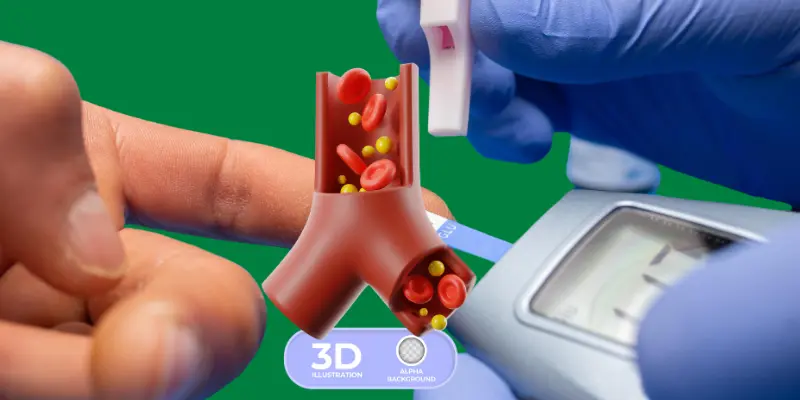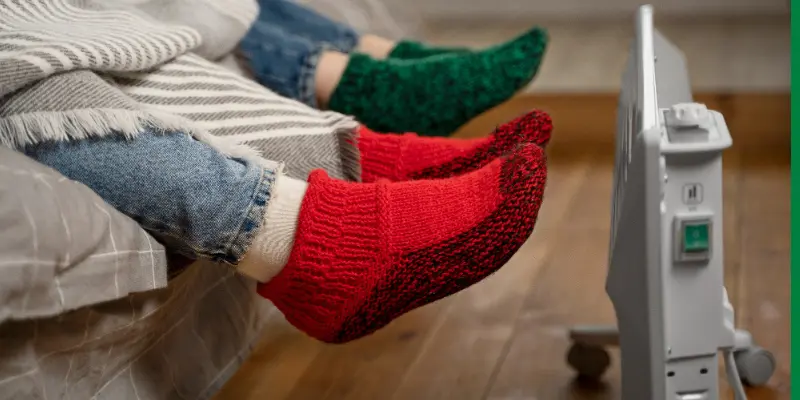Can Diabetics Use Heated Blankets or Pads?
Published: 27 Mar 2025
If you have diabetes, you probably know the struggle of freezing feet and legs that just won’t warm up, especially in winter. You might have thought about using a heating pad or electric blanket to get some relief.
But here’s the problem: diabetes can dull your ability to feel heat properly, turning a cosy solution into a hidden danger. This article will help you understand the risks, teach you how to stay safe, and show you safer ways to keep warm without risking burns.
1- Why Do Diabetics Struggle with Cold Sensitivity?
If you have diabetes, you’ve probably noticed that your feet and legs feel colder than usual, especially during winter. But why does this happen?

1.1 Diabetes and Poor Blood Circulation
Diabetes can harm your blood vessels over time.
- When sugar levels stay high, it damages these vessels and reduces blood flow, especially to your hands, feet, and legs.
- Without enough warm, oxygen-rich blood reaching these areas, they can feel cold and stiff.

Think of it like a blocked pipe: the less water (or blood) that gets through, the harder it is to keep things warm.
1.2 Diabetic Neuropathy: Nerve Damage
Diabetic neuropathy is another common reason.
- This condition occurs when high blood sugar damages nerves, especially in the lower legs and feet. These nerves help you sense temperature, pressure, and even pain.
- When they don’t work properly, you might not feel how hot or cold something really is.

| 2- Why Can’t Diabetics Use Heating Pads or Heated Blankets Freely? |
|---|
Suppose you’re wondering why diabetics can’t use heating pads as freely as others. In that case, the main reason is safety. Diabetes often causes nerve damage, called diabetic neuropathy, which reduces how well you feel heat on your skin. This makes heating pads and heated blankets riskier than they seem. 2.1 Burn Risks and Skin DamageWhen you can’t fully feel the heat, it’s easy to leave a heating pad or blanket on for too long without noticing. This can cause burns, skin blisters, or deep tissue injuries, especially in sensitive areas like your feet and legs.  2.2 Hidden Wounds Can Get WorseMany people with diabetes have foot ulcers (open sores) or small wounds that heal slowly. Using heated blankets or pads on these areas may make things worse. The heat increases moisture and warmth, which could slow healing or raise the risk of infections if wounds go unnoticed. 2.3 Overheating Dries the SkinDiabetics often struggle with dry skin already, and overheating from these devices can make it worse. Dry, cracked skin is more likely to get infected, especially on the feet, where circulation is poor. That’s why skincare is just as important as managing your blood sugar. |
Living with diabetes while working in high-demand roles? Comfort aids like heating pads might become your new best friend.
| 3- Is it Ever Safe? How to Use Heating Devices Carefully |
|---|
Good news: Yes, diabetics can sometimes use heating pads or heated blankets safely, but only if they take the right precautions. Here are some simple tips to help you stay warm without the risk: 3.1 Keep it LowAlways set your heating pad or blanket on low or medium heat. High settings can cause burns before you even notice something’s wrong. 3.2 Staying Awake While Using ItNever fall asleep while using heating devices. It’s easy to lose track of time or miss warning signs like redness or discomfort. 3.3 Check Your Skin OftenMake it a habit to regularly check the area for redness, blisters, or dry patches. If your skin feels too warm or looks irritated, stop using the device immediately. 3.4 Talk to Your DoctorBefore using heated blankets or pads regularly, it’s smart to ask your healthcare provider. They can tell you if it’s safe for you based on your specific condition, like how advanced your neuropathy or circulation problems might be. Quick tip: Consider setting a timer for your device so it automatically shuts off after a short time. |
4- Safer Alternatives to Heating Pads for Diabetics
If you’re worried about the risks of heating pads, you’re not alone. Many diabetics look for alternatives to heating pads that can keep them warm safely without harming their skin.
Here are a few diabetic-friendly options to consider:
4.1 Feet Warmers for Diabetics
Look for battery-operated foot warmers with temperature control settings. These are designed to warm your feet gradually and allow you to adjust the heat to a safe, comfortable level.

4.2 Heated Socks for Diabetics
Heated socks are made with diabetics in mind. They offer soft, low-level heat and are created to avoid overheating. Plus, they often have breathable materials to reduce skin irritation.

4.3 Leg Warming Blankets
Leg-warming blankets with gentle heat settings are a great way to warm up your legs safely. Choose ones with auto shut-off features for extra protection.

4.4 Natural and Non-Electric Options
Sometimes, simple solutions are best. Try thermal socks, wool blankets, or insulated winter footwear to keep warm without the risks of electric heat. These materials trap body heat and are safer for people with reduced sensation.
Tip: Always choose products labelled “safe for diabetics” when shopping for heated wearables or blankets.
When managing diabetes, being cautious with heat is key. Here’s what you should always steer clear of:
5.1 No Direct Contact with Bare Skin
Never place heating pads or blankets directly onto your bare skin. Always have a layer, like socks, a towel, or clothing, in between to lower the risk of burns.
5.2 Don’t Use on Open Wounds or Foot Ulcers
If you have sores, cuts, or diabetic foot ulcers, skip the heating devices altogether. Heat can worsen these issues or delay healing.
5.3 Avoid Cheap, Non-Regulated Devices
Be careful with low-quality or unregulated heating devices. They may lack proper temperature controls or auto-shutoff features, raising the risk of overheating or burns.
Tip: Always choose products labelled as safe for diabetics or recommended by healthcare professionals.
6- Conclusion
So, guys, in this article, we’ve covered Can Diabetics Use Heated Blankets or Pads? in detail. Based on what we’ve learned, I recommend sticking to safer alternatives like diabetic-friendly socks or leg warmers.
Heated pads and blankets can be useful but must be used with strict care. Personally, I always tell people, if you have diabetic neuropathy or poor circulation, consult your healthcare provider before using any heating devices.
7- FAQs
It’s not recommended. Diabetics may not feel if the blanket gets too hot, increasing the risk of burns or skin damage. If you really need to use one, keep it on a low setting and don’t fall asleep with it turned.
Yes, but only if they are made for diabetics. Choose heated socks with low, controlled heat and auto shut-off features. Always check your skin after use to avoid burns.
It can be risky. Diabetics with nerve damage may not feel if the heating pad gets too hot. Always use it on low heat, limit the time, and check your skin often.
Wear thick, moisture-wicking socks and insulated footwear. Try natural options like wool socks or thermal layers. Also, gentle foot exercises can help improve blood flow.
Because nerve damage (neuropathy) reduces their ability to feel heat properly. This makes it easy to get burned without noticing. That’s why diabetics need to be extra careful with heating devices.
Yes! Options like battery-powered foot warmers, heated socks for diabetics, or leg-warming blankets with temperature control are safer. Even layering up with thermal socks or wool blankets works well.
Yes, they can. Heating devices may dry out the skin or cause unnoticed burns, which can worsen ulcers. If you have ulcers, it’s best to avoid heating pads completely.
Leg-warming blankets with gentle, low-heat settings can be safer. Always check that they have safety features like auto shut-off. Don’t place them directly on bare skin.
Keep your room warm, wear insulated clothes, and do light exercises to boost circulation. Use safe warming devices made for diabetics. Always check your skin regularly for any redness or damage.
Absolutely, yes! Your doctor can help you decide which heating products are safe for your condition. It’s always better to get advice tailored to your specific health needs.
8- References
At MedicaWire, all medically sensitive content is reviewed by licensed healthcare professionals. Our team ensures that the information you read is accurate, up-to-date, and based on trusted medical sources.
Learn how we maintain high standards by reading our Editorial Policy.
📚 Sources
- Evaluation of thermal and vibration sensation in diabetic neuropathy
This study evaluates how diabetic neuropathy affects thermal sensitivity, underscoring the potential dangers of using heating devices.
https://pubmed.ncbi.nlm.nih.gov/3996794 - Preventing foot complications in patients with diabetes
This article discusses strategies to prevent foot complications in diabetic patients, including caution with heating devices.
https://pubmed.ncbi.nlm.nih.gov/31468824/ - Diabetic neuropathy.
This research highlights how diabetic neuropathy can lead to unrecognized injuries, stressing the importance of the careful use of heating devices.
https://pubmed.ncbi.nlm.nih.gov/31197183/
ℹ️ Our Promise
MedicaWire follows strict sourcing guidelines and only references peer-reviewed studies, academic institutions, and reputable medical associations. We update content regularly to reflect new health information.

- Be Respectful
- Stay Relevant
- Stay Positive
- True Feedback
- Encourage Discussion
- Avoid Spamming
- No Fake News
- Don't Copy-Paste
- No Personal Attacks



- Be Respectful
- Stay Relevant
- Stay Positive
- True Feedback
- Encourage Discussion
- Avoid Spamming
- No Fake News
- Don't Copy-Paste
- No Personal Attacks




